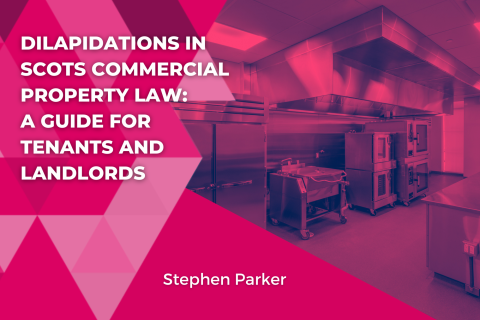For landlords, ensuring their property is well-maintained throughout the lease term and upon its termination is crucial. To achieve this, landlords rely on dilapidations — a process that holds tenants accountable for their obligations to repair, decorate, maintain and comply with statute under the lease.
In Scots law, the common law position under a lease is that landlords are responsible for repairing and maintaining the property throughout the duration of the lease. In practice, almost every landlord will transfer liability for repair, maintenance and decoration of the property to tenants through the lease terms. This is often referred to as a 'full repairing and insuring' or 'FRI' lease. Dilapidations refer to the remedial actions required from the tenant to restore the property to the agreed standard. When a tenant fails to meet these obligations, the landlord may seek to enforce the terms of the lease by serving a Schedule of Dilapidations.
A Schedule of Dilapidations is prepared by a surveyor on behalf of the landlord and gives a full breakdown of the relevant breaches under the terms of the lease, alongside a monetary figure for each repair. The Schedule of Dilapidations can be served on a tenant during the tenancy on an interim basis as an indication of the tenant's existing breaches of repair obligations, toward the end of a tenancy to indicate what repairs are required before termination of the lease or after a tenancy has terminated as a basis for a claim for breach of contract.
Dilapidations claims can also relate to a tenant's duty to remove any fixtures or fittings installed during the term of the lease or to restore the property back to its original conditions after the tenant has made alterations. Whether these apply will be contingent on the express terms of the lease.
How can a tenant best protect themselves from claims?
A tenant may seek to limit their liability by requesting a Schedule of Condition before taking entry to the property. This is a schedule which is annexed to the lease, usually containing comments with supporting photos which document the condition of the property prior to the date of entry. A tenant can seek for their repairing, decorating and maintenance obligations to be tied to the condition of the property as seen in the Schedule of Condition.
Additionally, a tenant should be properly informed about their obligations under the lease before entering the lease. For example, a particularly high repairing obligation under a long lease could leave the tenant responsible for replacing boilers or lifts, which have set lifespans. Tenants should be mindful of these instances where obligations may exceed general wear and tear.
A landlord should be aware of any time limits surrounding making a dilapidations claim under the lease. The lease may specify a time after which, no claim may be made. Importantly, such deadlines may be in other related lease documentation. For instance, the deadline for demanding a tenant remove their alterations under a fit out may only be located in a separate licence for works if agreed between the parties, rather than in the lease.
Additionally, only those parts of property which are included in the description of the 'leased subjects' can be subject to a dilapidations claim. This could mean that common parts could be excluded and a landlord should be careful to distinguish what should be included under the lease at its creation. It is also important that the Schedule of Dilapidations is served on the tenant in accordance with any formal notices clause that exists within the lease.
Understanding dilapidations in Scots property law is crucial for tenants and landlords. Clear communication, documentation, and awareness of timelines are vital for effective claims management. By navigating these issues, both parties can build a harmonious leasing relationship. Landlords and tenants should seek professional advice when drafting a lease, reviewing obligations, or preparing a Schedule of Condition. Our Commercial Property experts can provide clarity and support, help explore options and develop strategies that simplify the decision-making process. Contact us at 0141 221 1919 for a personalised consultation, and we will take the time to understand your unique situation, address any concerns, and provide tailored solutions that make a real difference.















